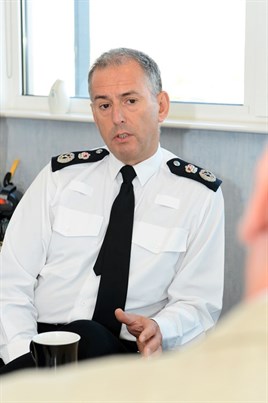“Transport for London and the Underground invest very heavily in policing, more so than the rest of the network. Network Rail is our biggest funder, but TfL is second. There are significantly more resources in London because TfL wants to pay for them.
“The Underground itself has been transformed in the last ten years. Stations are brightly lit, with pretty good CCTV, and they almost exclusively use ticket barriers.
“Look at the crimes which worry travellers most: knife-point robberies. We have reduced them by 83% in ten years. If you map robbery hot spots on the street and in the stations alongside, there is no correlation between them. The Tube stations have become oases of peace and serenity compared with the areas outside. That must be down to lighting, barriers, and station staff that people can turn to for help.”
A crime detection rate of 34% is broadly in line with other forces, says Crowther. The theft detection rate is only 7%, an area highlighted by the House of Commons Transport Select Committee as needing urgent action.
Crowther responds: “There has been a lot said on detection rates. I am more interested in stopping crimes happening in the first place. We have seen a 24% reduction in theft crimes on the Underground.”
Unlike most crime areas, the victim and the suspect on the railway are rarely known to each other before the incident. They are transient encounters, passing ships in the night. The suspect is quickly many miles away, making detection and detention more difficult.
Other police forces dealing with violent crime find that in most cases the victim knows the offender, whether the incidents are domestic, at work or in places of entertainment. For that reason, Crowther believes a detection rate of one in three compares favourably with other forces.
From the Chief Constable’s top-floor office window looking north from Camden, the London Overground can be seen on a brick viaduct. Formerly the North London Line was branded Silverlink, when it endured a rough image.
“It used to be a robbery hot-spot. It has been transformed. Some of that is down to us. But it is brighter, more welcoming with great CCTV - that’s a game-changer on the trains.
“We know from our work with offenders that they used to carry out robberies on trains because there were cameras on the platforms but not on the trains. Now there is high-quality CCTV on the open-plan trains, and that really contributes to safety and security. That line has become one of the most improved in the country, in terms of passenger confidence.”
Until recently, Crowther took the lead national policing policy-making role on CCTV cameras. Not surprisingly, he feels they play a big part in passengers’ sense of security.
“I’ve always described the UK as CCTV-rich. And the transport sector is CCTV-saturated. We have a CCTV hub in London that has access to 55,000 cameras. The challenge is how to deal with that effectively, and how to deal with public expectation - people think every event must be detectable instantly.”
Sex crime
Hundreds of millions of passenger journeys are made each year in complete safety. Last year there were almost 51,000 notifiable crimes (the more serious offences). That was a drop of 5.7% on the year before.
Within that, robberies reduced by 17%, as did theft of passenger property. Fraud was down by half.
But violence against people rose slightly. And sexual offences were up by a fifth, a stand-out figure completely against the general trend of other crime.
“If you look across the national crime figures, there has been a 20% rise in sexual offences. Ours are in line with that,” says Crowther.
“It’s widely accepted that the recent high-profile celebrity cases have brought greater awareness, and people are now more confident about reporting these offences.
“We launched Project Guardian in April 2013. We have done a lot of analysis with TfL, the Met and City of London Police, looking at incidents of sexual offences on the transport system. Some were crimes - sex assaults, touching. Others were passengers telling us about inappropriate comments, being leered at, feeling harassed by people around them. Fifteen per cent of women said they had experienced some form of unwanted sexual behaviour. Putting men and women together, the figure was 9%.
“A major part of Project Guardian was to increase reporting. So it is not surprising that is what has happened - it’s what we set out to do.
“Now we have more plain clothes officers, greater use of CCTV, and we are going after the offenders. We’ve dealt with 22% more offenders in the same period, so we largely reflect national trends and priorities.”












